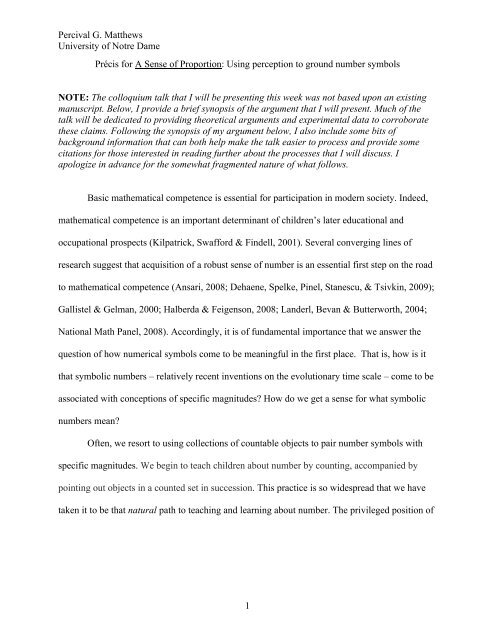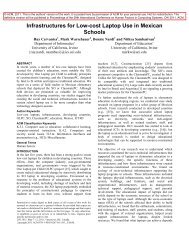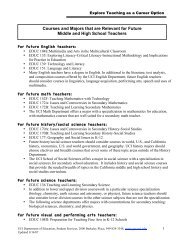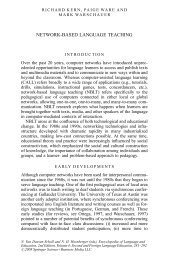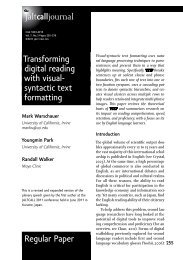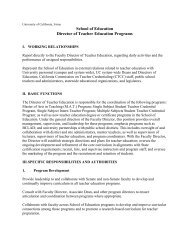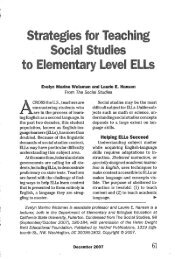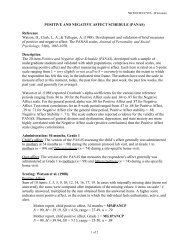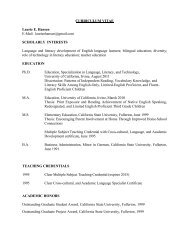A Sense of Proportion: Using perception to ground number symbols
A Sense of Proportion: Using perception to ground number symbols
A Sense of Proportion: Using perception to ground number symbols
Create successful ePaper yourself
Turn your PDF publications into a flip-book with our unique Google optimized e-Paper software.
Percival G. Matthews<br />
University <strong>of</strong> Notre Dame<br />
Précis for A <strong>Sense</strong> <strong>of</strong> <strong>Proportion</strong>: <strong>Using</strong> <strong>perception</strong> <strong>to</strong> <strong>ground</strong> <strong>number</strong> <strong>symbols</strong><br />
NOTE: The colloquium talk that I will be presenting this week was not based upon an existing<br />
manuscript. Below, I provide a brief synopsis <strong>of</strong> the argument that I will present. Much <strong>of</strong> the<br />
talk will be dedicated <strong>to</strong> providing theoretical arguments and experimental data <strong>to</strong> corroborate<br />
these claims. Following the synopsis <strong>of</strong> my argument below, I also include some bits <strong>of</strong><br />
back<strong>ground</strong> information that can both help make the talk easier <strong>to</strong> process and provide some<br />
citations for those interested in reading further about the processes that I will discuss. I<br />
apologize in advance for the somewhat fragmented nature <strong>of</strong> what follows.<br />
Basic mathematical competence is essential for participation in modern society. Indeed,<br />
mathematical competence is an important determinant <strong>of</strong> children’s later educational and<br />
occupational prospects (Kilpatrick, Swafford & Findell, 2001). Several converging lines <strong>of</strong><br />
research suggest that acquisition <strong>of</strong> a robust sense <strong>of</strong> <strong>number</strong> is an essential first step on the road<br />
<strong>to</strong> mathematical competence (Ansari, 2008; Dehaene, Spelke, Pinel, Stanescu, & Tsivkin, 2009);<br />
Gallistel & Gelman, 2000; Halberda & Feigenson, 2008; Landerl, Bevan & Butterworth, 2004;<br />
National Math Panel, 2008). Accordingly, it is <strong>of</strong> fundamental importance that we answer the<br />
question <strong>of</strong> how numerical <strong>symbols</strong> come <strong>to</strong> be meaningful in the first place. That is, how is it<br />
that symbolic <strong>number</strong>s – relatively recent inventions on the evolutionary time scale – come <strong>to</strong> be<br />
associated with conceptions <strong>of</strong> specific magnitudes How do we get a sense for what symbolic<br />
<strong>number</strong>s mean<br />
Often, we resort <strong>to</strong> using collections <strong>of</strong> countable objects <strong>to</strong> pair <strong>number</strong> <strong>symbols</strong> with<br />
specific magnitudes. We begin <strong>to</strong> teach children about <strong>number</strong> by counting, accompanied by<br />
pointing out objects in a counted set in succession. This practice is so widespread that we have<br />
taken it <strong>to</strong> be that natural path <strong>to</strong> teaching and learning about <strong>number</strong>. The privileged position <strong>of</strong><br />
1
Percival G. Matthews<br />
University <strong>of</strong> Notre Dame<br />
natural <strong>number</strong>s is epi<strong>to</strong>mized by Kronecker’s <strong>of</strong>t-quoted charge that, “God created the natural<br />
<strong>number</strong>s; all else is the work <strong>of</strong> man.” 1<br />
In this talk, I will present a second and complementary option for <strong>ground</strong>ing <strong>number</strong><br />
<strong>symbols</strong> – one that rests on our perceptual abilities <strong>to</strong> judge (and <strong>to</strong> match) proportions between<br />
continuous stimuli <strong>of</strong> various sizes. The implication is that nature may have provided us with a<br />
cognitive architecture that allows perceptual access <strong>to</strong> more than just natural <strong>number</strong>s. I will<br />
provide clear evidence that this “sense” <strong>of</strong> proportion exists and discuss the potential<br />
applications for pedagogy.<br />
I. THE ARGUMENT – PROPORTION MATCHING CAN BE USED TO MAKE NUMBERS<br />
MEANINGFUL.<br />
A. Human beings have a perceptually based ability <strong>to</strong> judge the proportions between<br />
magnitudes that are presented in the same representational format. For example, people<br />
can sense that the proportion between the two circles presented here is about ½ (I’ll prove<br />
it):<br />
a.<br />
B. Human beings can match these proportions across representational formats. It’s actually<br />
required when we do <strong>number</strong> line estimation tasks. In order <strong>to</strong> properly place the hatch<br />
1 Sometimes the quote is translated as referring <strong>to</strong> integers instead <strong>of</strong> <strong>to</strong> natural <strong>number</strong>s.<br />
2
Percival G. Matthews<br />
University <strong>of</strong> Notre Dame<br />
mark on a task that asks you <strong>to</strong> estimate where 50 should go on a <strong>number</strong> line that goes<br />
from 0 <strong>to</strong> 100, you have <strong>to</strong> use this ability <strong>to</strong> match proportions:<br />
!"#<br />
a.<br />
"# $""#<br />
b. The only way <strong>to</strong> complete this task is <strong>to</strong> match the appropriate proportion <strong>of</strong> two<br />
line lengths (the length from 0 <strong>to</strong> 50 and the <strong>to</strong>tal length) <strong>to</strong> the proportion<br />
between the stimulus and the rightmost anchor <strong>of</strong> the <strong>number</strong> line (50:100).<br />
% $#<br />
!"#<br />
! "#<br />
"# % $""#<br />
c. &#<br />
so that<br />
! $#<br />
%#<br />
&' #<br />
"'' #<br />
C. Because these tasks a) are inherently relational, and b) involve matching perceptually<br />
perceived proportions <strong>to</strong> symbolic proportions, they might be used <strong>to</strong> bootstrap existing<br />
symbolic knowledge via a sort <strong>of</strong> perceptual analogy. For instance, the setup below<br />
should be helpful for children who understand the symbol “4” but have not yet mastered<br />
the symbol “8”. It rests on our perceptual abilities <strong>to</strong> match proportions. It shows that 8<br />
is twice as big as 4.<br />
a.<br />
! #$<br />
"<br />
D. If we can perceptually access the ratios between different magnitudes, on some level, we<br />
may have perceptual access <strong>to</strong> rational (even real) <strong>number</strong>s. It has yet <strong>to</strong> be shown<br />
whether or not we can harness this system for practical use, but one thing is certain: in the<br />
3
Percival G. Matthews<br />
University <strong>of</strong> Notre Dame<br />
figure below, there is a 1-<strong>to</strong>-1 map between the visuospatial proportion presented and the<br />
fraction 1/3.<br />
a.<br />
I will present some evidence that suggests that we do have a sense <strong>of</strong> proportion, and that<br />
it is actually a perceptual phenomenon that is substantially different from our standard<br />
count-based sense <strong>of</strong> fractions which is predicated on equisection <strong>of</strong> the whole in<strong>to</strong><br />
discrete units.<br />
!"<br />
#"<br />
E. When you strip this argument <strong>to</strong> bare bones, it proposes that we can use continuous<br />
magnitudes – things that are inherently non-numerical – <strong>to</strong> gain access <strong>to</strong> <strong>number</strong>s. The<br />
key is <strong>to</strong> use them relationally <strong>to</strong> facilitate 1-<strong>to</strong>-1 maps <strong>to</strong> <strong>number</strong>s. Because this ability <strong>to</strong><br />
judge and match proportions is innate <strong>to</strong> our cognitive architecture, it is a <strong>to</strong>ol that we<br />
should attempt <strong>to</strong> exploit for pedagogical purposes. It may be a large fac<strong>to</strong>r underlying<br />
recent success using <strong>number</strong> lines as pedagogical <strong>to</strong>ols. Explicit attempts <strong>to</strong> leverage this<br />
system may pay dividends both with typically and atypically developing populations.<br />
4
Percival G. Matthews<br />
University <strong>of</strong> Notre Dame<br />
II. THE NUMBER SENSE(S)<br />
The term ‘<strong>number</strong> sense’ is used by diverse camps, sometimes <strong>to</strong> mean very different<br />
things (Berch, 2005). For the purposes <strong>of</strong> introducing the series <strong>of</strong> experiments that I will discuss<br />
in the colloquium, this section will focus on two conceptions <strong>of</strong> ‘<strong>number</strong> sense’ which are<br />
thought <strong>to</strong> contribute <strong>to</strong> early understanding <strong>of</strong> numerical magnitude: 1) the approximate<br />
<strong>number</strong> system (ANS) that allows us <strong>to</strong> discriminate between nonsymbolic numerosities (e.g.<br />
, and 2) the ability <strong>to</strong> generate estimates <strong>of</strong> numerical magnitude using <strong>number</strong> lines<br />
!"#<br />
"#<br />
(e.g.<br />
$""#<br />
).<br />
<strong>Sense</strong> 1 – The Approximate Number System (ANS)<br />
Several strands <strong>of</strong> converging evidence have led some <strong>to</strong> suggest that meaningful<br />
understanding <strong>of</strong> the magnitude <strong>of</strong> symbolic <strong>number</strong> is rooted in the evolutionarily ancient ANS<br />
(e.g. Nieder & Dehaene, 2009; Mazzocco & Devlin, 2008; Nieder & Dehaene, 2009). The ANS<br />
is a perceptual system that allows animals <strong>to</strong> discriminate between two sets <strong>of</strong> nonsymbolic<br />
numerosities. Notably, the system is dependent upon the ratios between the sets as opposed <strong>to</strong><br />
the raw numerical differences between them. Hence, it is easier <strong>to</strong> discriminate between arrays <strong>of</strong><br />
40 and 80 dots (a 1:2 ratio) than it is <strong>to</strong> discriminate between arrays <strong>of</strong> 120 and 160 dots (a 3:4<br />
ratio). This system is 1) found across a wide range <strong>of</strong> species and 2) present in humans at birth,<br />
although the acuity <strong>of</strong> it is enhanced with development (Dehaene, 1997; Halberda & Feigenson,<br />
2008; Hubbard, Diester, Cantlon, Ansari, van Opstal & Troiani, 2008). Importantly, this ability<br />
<strong>to</strong> discriminate between nonsymbolic <strong>number</strong> seems <strong>to</strong> work in much the same way as our<br />
abilities <strong>to</strong> discriminate between magnitudes more generally 2 (Moyer & Landauer, 1967).<br />
This ratio dependent discrimination system also leads <strong>to</strong> some characteristic patterns on<br />
2 Here, I mean our abilities <strong>to</strong> discriminate between pairs <strong>of</strong> magnitudes in many different<br />
domains: temporal durations, lengths, masses, areas <strong>of</strong> circles, etc. See Feigenson, 2007 for a<br />
developmental perspective. Stevens, 1970 is a (slightly less accessible, but equally brief) intro <strong>to</strong><br />
the concept for adult participants.<br />
5
Percival G. Matthews<br />
University <strong>of</strong> Notre Dame<br />
estimation tasks. Simply put, perceived differences in magnitude are somewhat dis<strong>to</strong>rted relative<br />
<strong>to</strong> actual differences in magnitude because our perceptual system is sensitive <strong>to</strong> ratios. For<br />
example, when presented with dot arrays, the difference between 10 and 20 dots is perceived as<br />
the same as the difference between 20 and 40 dots or the difference between 40 and 80 dots,<br />
because the ratios between the pairs is constant. 3<br />
As a result, when people are asked <strong>to</strong> estimate<br />
how many dots are in various arrays, presented one at a time, plotting the estimates vs. the actual<br />
<strong>number</strong>s <strong>of</strong> dots in the arrays leads <strong>to</strong> a function like the one presented below (Indow & Ida,<br />
1977; Izard & Dehaene, 2008; Taves, 1941).<br />
'!!"<br />
!"#$%&'($)"*+$&,-$<br />
*.-,-$.-,-/$<br />
!"#$"%&"'!"#$%&'()*!<br />
&!"<br />
%!"<br />
$!"<br />
#!"<br />
!"<br />
.,-/,!<br />
+,-.,!<br />
/,-0,!<br />
!" #!" $!" %!" &!" '!!"<br />
!!!($)*+,!"#$%&'()*!<br />
FIGURE: When estimating how many dots are in various individual arrays like the one<br />
presented on the left, graphs <strong>of</strong> median estimates vs. the actual stimulus <strong>number</strong> usually look like<br />
the graph on the right.<br />
Past research has shown that our abilities <strong>to</strong> discriminate between pairs <strong>of</strong> symbolic<br />
<strong>number</strong>s follow similar rules. The seminal work by Moyer and Landauer (1967) is perhaps the<br />
most well known <strong>of</strong> these studies. In that experiment, the authors presented adult subjects with<br />
3 This is provided that a person is required <strong>to</strong> answer quickly and without counting – an<br />
estimation at a glance.<br />
6
Percival G. Matthews<br />
University <strong>of</strong> Notre Dame<br />
pairs <strong>of</strong> single digit numerals from 1-9 and instructed them <strong>to</strong> indicate which <strong>of</strong> the two digits<br />
was larger. Participants were <strong>to</strong>ld <strong>to</strong> respond as quickly as possible without making errors.<br />
Analysis <strong>of</strong> reaction time data showed that the ability <strong>to</strong> discriminate between these symbolic<br />
<strong>number</strong>s was also dependent on the ratios between the numerical stimuli presented. The closer<br />
the ratio was <strong>to</strong> 1:1, the longer the participants <strong>to</strong>ok <strong>to</strong> react.<br />
This research was an anchor for other research that suggests that we use the ANS <strong>to</strong><br />
<strong>ground</strong> symbolic <strong>number</strong>s. Simple intuition suggests that our sense <strong>of</strong> the meaning <strong>of</strong> symbolic<br />
<strong>number</strong>s should be rooted in displays <strong>of</strong> discrete quantity: we begin <strong>to</strong> teach children about<br />
<strong>number</strong> by counting, <strong>of</strong>ten accompanied by pointing out objects in a counted set in succession.<br />
With this experiment, however, there was clear evidence that residues <strong>of</strong> the very ways that we<br />
perceive <strong>of</strong> discrete sets <strong>of</strong> objects (qua perceptual magnitudes) were present in the ways that we<br />
processed symbolic <strong>number</strong>s.<br />
Much, however remains unclear about the role that the ANS plays in <strong>ground</strong>ing<br />
numerical <strong>symbols</strong>. First, the process by which the quantities represented by the ANS are<br />
mapped on<strong>to</strong> symbolic <strong>number</strong>s is not at all clear. Moreover, it is not clear that there are not<br />
other equally important pathways by which humans might gain access <strong>to</strong> semantics <strong>of</strong> numerical<br />
magnitude in order <strong>to</strong> <strong>ground</strong> numerical <strong>symbols</strong>. For instance, some have argued that magnitude<br />
comparison <strong>of</strong> numerical and non-numerical stimuli is accomplished using similar mechanisms<br />
(Walsh 2003). This suggests the possibility that some non-ANS based mode <strong>of</strong> expressing<br />
magnitude – such as the visuospatial representation <strong>of</strong> relative length – might provide an<br />
alternative <strong>ground</strong> making symbolic <strong>number</strong>s meaningful. In fact, space is a particularly strong<br />
candidate for <strong>ground</strong>ing symbolic <strong>number</strong>, as several lines <strong>of</strong> research show strong associations<br />
between <strong>number</strong> and space (see Hubbard Piazza, Pinel & DeHaene, 2005 for a review). This<br />
7
Percival G. Matthews<br />
University <strong>of</strong> Notre Dame<br />
association between magnitude and space is strongly implicated in the second type <strong>of</strong> <strong>number</strong><br />
sense, discussed below.<br />
<strong>Sense</strong> 2 – Number Line Estimation<br />
Siegler, Booth and colleagues have taken a somewhat different tack in exploring <strong>number</strong><br />
sense. These researchers have defined <strong>number</strong> sense as the ability <strong>to</strong> estimate numerical<br />
magnitudes. this take on the <strong>number</strong> sense focuses on the ability <strong>to</strong> generate <strong>number</strong>s whose<br />
magnitudes are close <strong>to</strong> correct values for the various types <strong>of</strong> estimation questions posed.<br />
Perhaps the most well known <strong>of</strong> these numerical estimation tasks is the <strong>number</strong> line estimation<br />
task. This task requires that participants estimate the location <strong>of</strong> a <strong>number</strong> on a line with<br />
numerical anchors at each end. This task not only involves magnitude estimation, but also the<br />
ability <strong>to</strong> translate between symbolic <strong>number</strong>s and mental magnitudes.<br />
Siegler and colleagues have helped illuminate a typical developmental trend observed on<br />
such <strong>number</strong> line tasks: young children show a tendency <strong>to</strong> compress <strong>number</strong>s logarithmically,<br />
whereas adults do not (e.g. Siegler & Booth, 2004; Booth & Siegler, 2006; Booth and Siegler,<br />
2008. The figure below is from Siegler & Booth, 2004). That is, when asked <strong>to</strong> mark the<br />
position where a <strong>number</strong> n is on the line, children typically place the mark at a spot<br />
approximated by log(n) instead <strong>of</strong> n. With development, these estimates become more linear<br />
(Siegler & Opfer, 2003). Importantly, increased linearity <strong>of</strong> children’s magnitude estimates<br />
predicts a wide range <strong>of</strong> numeracy measures, including counting ability, <strong>number</strong> naming, digit<br />
magnitude comparison, and achievement test scores (Ramani & Siegler, 2008; Siegler & Booth,<br />
2004).<br />
8
Percival G. Matthews<br />
University <strong>of</strong> Notre Dame<br />
This developmental trend, labeled the ‘log-<strong>to</strong>-linear shift’, has been interpreted as<br />
evidence <strong>of</strong> a developmental change in the underlying subjective representations <strong>of</strong> the<br />
numerical magnitudes denoted by symbolic <strong>number</strong>s. According <strong>to</strong> the log-<strong>to</strong>-linear shift<br />
hypothesis, the curve found in young children’s’ <strong>number</strong> line estimations is analogous <strong>to</strong> the<br />
curvature found in other raw estimation tasks (as described above). This interpretation<br />
presupposes that children’s performance on <strong>number</strong> line estimation tasks initially reflects the<br />
perceptual influence <strong>of</strong> the approximate <strong>number</strong> system that we share with nonhuman animals<br />
(Siegler, 2009; Siegler & Opfer, 2003). Siegler and colleagues further theorize that when<br />
children start <strong>to</strong> make linear predictions, they are moving away from reliance on the core<br />
perceptual system <strong>of</strong> the ANS <strong>to</strong> reliance on the formal, school-taught system. This explanation<br />
<strong>of</strong> the log-<strong>to</strong>-linear shift is currently popular in cognitive psychology (e.g. Dehaene, Izard,<br />
Spelke & Pica, 2008), developmental psychology (e.g. Whyte & Bull, 2008), and special<br />
education research (e.g., Fuchs, Geary, Comp<strong>to</strong>n, Fuchs, Hamlet & Bryant 2010). It has even<br />
influenced the policy oriented reports <strong>of</strong> the National Math Advisory Panel (2008).<br />
9
Percival G. Matthews<br />
University <strong>of</strong> Notre Dame<br />
III. A CRITIQUE OF THE LOG-TO-LINEAR SHIFT HYPOTHESIS<br />
It is important that I <strong>of</strong>fer a critique <strong>of</strong> the log-<strong>to</strong>-linear shift hypothesis, because the<br />
paradigm is somewhat contradic<strong>to</strong>ry <strong>to</strong> the proportion matching account that I <strong>of</strong>fer. To<br />
summarize the discrepancy, my proportion matching account relies upon the premise that using<br />
the perceptual system <strong>to</strong> make estimations on bounded lines (like <strong>number</strong> lines, and other<br />
perceptually-based tasks that are similar <strong>to</strong> <strong>number</strong> lines, see figure below) should yield linear<br />
estimation patterns. The log-<strong>to</strong>-linear shift hypothesis, however, predicts that using the<br />
perceptual system should lead <strong>to</strong> logarithmically curved estimates on these tasks.<br />
!"#<br />
"# $""#<br />
FIGURE: Each <strong>of</strong> these three tasks requires estimating where a stimulus (above the line) should<br />
be place on a line bounded by stimuli at both ends. Each requires matching proportions <strong>of</strong><br />
presented stimuli <strong>to</strong> the corresponding proportions <strong>of</strong> line lengths (for more on this, see<br />
Matthews & Chesney, 2011).<br />
My critique relies heavily upon that <strong>of</strong>fered by Barth and Paladino (2010). I extend the<br />
argument by providing direct evidence that viewing magnitudes in isolation vs. viewing those<br />
same magnitudes on bounded lines should au<strong>to</strong>matically result in linear estimates, even when the<br />
perceptual system is used <strong>to</strong> judge magnitudes. I also extend the argument <strong>of</strong> Barth and Paladino<br />
by showing that proportions between magnitudes in multiple formats (not just line lengths) can<br />
be mapped back <strong>to</strong> symbolic <strong>number</strong>s. The section below will provide a bit more information on<br />
why <strong>number</strong> line estimation should be seen as a type <strong>of</strong> proportion judgment.<br />
The log-<strong>to</strong>-linear shift hypothesis is not without controversy. A recent critique put forth<br />
by Barth and Paladino (2010) raised questions about the interpretation <strong>of</strong> children’s apparently<br />
logarithmic performance (see also Cohen & Blanc-Goldhammer, 2011). Barth and Paladino<br />
argue that estimating the proper placement <strong>of</strong> a <strong>number</strong> on a <strong>number</strong> line is not quite the same as<br />
estimating the size <strong>of</strong> a <strong>number</strong> seen in isolation. Rather, such placement tasks are actually a<br />
form <strong>of</strong> proportion judgment task – a task in which the ratio between items must be evaluated.<br />
Indeed, previous literature in psychophysics has shown that estimation tasks that combine two<br />
measures in a complementary fashion such that they sum <strong>to</strong> a fixed <strong>to</strong>tal should be characterized<br />
as proportion judgment tasks (e.g., Hollands & Dyre, 2000; Spence, 1990; Stevens, 1957). Thus,<br />
10
Percival G. Matthews<br />
University <strong>of</strong> Notre Dame<br />
because estimating a <strong>number</strong>’s place on a <strong>number</strong> line involves both the estimate <strong>of</strong> that<br />
<strong>number</strong>s’ placement relative <strong>to</strong> the zero anchor point and <strong>of</strong> its complement’s placement relative<br />
<strong>to</strong> the rightmost anchor, the task is essentially a proportion judgment. For example, when placing<br />
25 on a 0-100 line, it should be 25 units away from 0, and 75 units away from 100, and should<br />
therefore be placed 25/(25+75), or one fourth <strong>of</strong> the <strong>to</strong>tal length <strong>of</strong> the line away from 0.<br />
<strong>Proportion</strong> judgment tasks tend <strong>to</strong> yield linear relationships between the actual proportion<br />
<strong>of</strong> the stimulus presented and the judged proportion, even when using stimuli for which<br />
estimation in isolation yields a curved relationship between actual and perceived stimulus<br />
intensity (Hollands & Dyre, 2000; Spence, 1990). This linear performance results because the<br />
underlying curved function is mapped <strong>to</strong> distances according <strong>to</strong> what Spence (1990) termed a<br />
power model, which approximates linearity because <strong>of</strong> the reference points that are perceived<br />
linearly. Importantly, this model predicts linear performance even given a curved underlying<br />
representation <strong>of</strong> <strong>number</strong> (see Figure below, reproduced from Hollands & Dyre, 2000).<br />
+),0)%1)(*!"#$%&'()*<br />
'!!"<br />
&!"<br />
%!"<br />
$!"<br />
#!"<br />
!"<br />
!" #!" $!" %!" &!" '!!"<br />
+),0)%1)(*+,-.-,/-$*<br />
'!!"<br />
&!"<br />
%!"<br />
$!"<br />
#!"<br />
!"<br />
!" #!" $!" %!" &!" '!!"<br />
!"#$%&'()* +,-.-,/-$*<br />
FIGURE: According <strong>to</strong> psychophysics models, seeing a magnitude in isolation should yield a<br />
function like the one on the left, whereas judging the magnitude as a proportion <strong>of</strong> whole should<br />
yield a function on the right. As an application, I’ve investigated whether we should expect<br />
different patterns when investigating stimuli such as vs. .<br />
11
Percival G. Matthews<br />
University <strong>of</strong> Notre Dame<br />
This perspective raises questions regarding young children’s apparently logarithmic<br />
performance on <strong>number</strong> line estimation tasks. Why, given that <strong>number</strong> line estimation is a<br />
proportion judgment task, do children’s representations appear <strong>to</strong> be nonlinear in the first place,<br />
when psychophysics – even given a logarithmic underlying representation <strong>of</strong> <strong>number</strong> magnitude<br />
– might predict otherwise One possible answer is that certain assumptions <strong>of</strong> the psychophysics<br />
proportion judgment model may be violated when young children perform <strong>number</strong> line<br />
estimation tasks, impeding their use <strong>of</strong> the default comparison procedure for performing the<br />
tasks.<br />
To judge a proportion, one must know the approximate magnitude <strong>of</strong> the whole (i.e., the<br />
rightmost anchor on a <strong>number</strong> line). Indeed, the proportion judgment model assumes that<br />
participants have access <strong>to</strong> the magnitudes at both ends <strong>of</strong> the line. Although this assumption is<br />
logical when perceptual continua are used <strong>to</strong> indicate the anchors at each end <strong>of</strong> the line (e.g., bar<br />
length on a bar graph, see Spence, 1990), this is not necessarily the case with tasks that require<br />
young children <strong>to</strong> understand the magnitudes <strong>of</strong> symbolic <strong>number</strong>s. Essentially, people who do<br />
not have a correct understanding <strong>of</strong> the values represented by both the high and low anchor<br />
points lack the knowledge needed <strong>to</strong> fully render <strong>number</strong> line estimation tasks as proportion<br />
judgment tasks.<br />
Extant research on children’s abilities <strong>to</strong> identify symbolic <strong>number</strong>s by name provides<br />
some evidence children do lack the symbol knowledge that is assumed by current interpretations<br />
<strong>of</strong> <strong>number</strong> line estimation patterns. For example, young children <strong>of</strong>ten cannot consistently name<br />
symbolic <strong>number</strong>s above twenty, even when they can recite those <strong>number</strong>s as part <strong>of</strong> the count<br />
sequence (Wright, 1991; see also Clarke & Shinn, 2004). One might question whether estimates<br />
12
Percival G. Matthews<br />
University <strong>of</strong> Notre Dame<br />
based on any unrecognizable <strong>number</strong> should have a one-<strong>to</strong>-one mapping <strong>to</strong> any particular<br />
numerical magnitude. Unfortunately, no <strong>number</strong> line estimation experiments have included<br />
alternative measures <strong>of</strong> children’s knowledge <strong>of</strong> <strong>number</strong> <strong>symbols</strong> for <strong>symbols</strong> greater than 20.<br />
I will present data from an experiment with Kindergarten participants that includes such<br />
alternative measures alongside <strong>number</strong> line estimation data. The evidence is consistent with my<br />
claim that these children’s ostensibly logarithmic performance on 0-100 <strong>number</strong> lines may<br />
actually be an artifact <strong>of</strong> children’s unfamiliarity with <strong>number</strong> <strong>symbols</strong>. I will show that<br />
children’s knowledge <strong>of</strong> <strong>number</strong> <strong>symbols</strong> in this case was insufficiently stable <strong>to</strong> support the log<strong>to</strong>-linear<br />
shift hypothesis. These arguments have important implications for the validity <strong>of</strong> what<br />
is currently a very popular methodology.<br />
IV. A SENSE OF PROPORTION<br />
Much <strong>of</strong> the literature on the <strong>perception</strong> <strong>of</strong> magnitude argues that our <strong>perception</strong> <strong>of</strong><br />
magnitude is sensitive <strong>to</strong> ratio. To date, this ratio sensitivity has been deduced either 1) from<br />
reaction times in discrimination tasks or 2) from the characteristic curvature found in magnitude<br />
estimation tasks. My findings motivated me <strong>to</strong> investigate whether college undergraduates could<br />
directly generate fractions corresponding <strong>to</strong> the ratios they perceived in figures like the ones<br />
shown below. I presented figures like these <strong>to</strong>o rapidly for participants <strong>to</strong> count or <strong>to</strong> use<br />
equations (1500 ms), instructing them instead <strong>to</strong> feel out the ratios.<br />
13
Percival G. Matthews<br />
University <strong>of</strong> Notre Dame<br />
Despite their lack <strong>of</strong> confidence, undergraduates were amazingly accurate at assigning<br />
appropriate fraction values <strong>to</strong> these visuospatially presented ratios. This means that we have<br />
direct perceptual access <strong>to</strong> the ratios between pairs <strong>of</strong> magnitudes. Moreover, variance patterns<br />
for these tasks were similar <strong>to</strong> those obtained from the analogs <strong>to</strong> the <strong>number</strong> line estimation<br />
(e.g.<br />
). This can be interpreted as further confirmation that tasks<br />
requiring participants <strong>to</strong> estimate the placement <strong>of</strong> magnitudes on bounded lines (including<br />
<strong>number</strong> line estimation) are indeed proportion matching tasks. Unpacking the crossrepresentational<br />
proportion matching aspect <strong>of</strong> the task opens up the possibility that the one<br />
mechanism by which <strong>number</strong> lines help improve symbolic <strong>number</strong> knowledge may involve<br />
leveraging our perceptual system <strong>to</strong> inform our understandings <strong>of</strong> the relative magnitudes<br />
between symbolic <strong>number</strong>s.<br />
As you’ll note, this section doesn’t include citations. This is simply because there aren’t<br />
any. The paradigm is original, 4 and I’m in the process <strong>of</strong> fleshing it out and exploring its<br />
potential applications for pedagogical purposes.<br />
References<br />
Ansari, D. (2008) Effects <strong>of</strong> development and enculturation on <strong>number</strong> representation in the<br />
brain. Nature Reviews Neuroscience, 9, 278-91.<br />
Barth, H. C., & Paladino, A. M. (2010). The development <strong>of</strong> numerical estimation: evidence<br />
against a representational shift. Developmental Science, 14, 125-135.<br />
Berch DB. Making sense <strong>of</strong> <strong>number</strong> sense: Implications for children with mathematical<br />
disabilities. Journal <strong>of</strong> Learning Disabilities. 2005;38(4):333–339.<br />
4 Actually, I did find a reference <strong>to</strong> some sort <strong>of</strong> proportion judgment task in Taves (1941) that<br />
may possibly have examined a similar phenomenon. The problem is that there were no figures,<br />
and textual explanation <strong>of</strong> the design was <strong>to</strong>o brief <strong>to</strong> get a picture <strong>of</strong> what all was involved with<br />
the task.<br />
14
Percival G. Matthews<br />
University <strong>of</strong> Notre Dame<br />
Booth, J. L., & Siegler, R. S. (2006). Developmental and individual differences in pure<br />
numerical estimation. Developmental Psychology, 42, 189-201.<br />
Booth, J. L., & Siegler, R. S. (2008). Numerical magnitude representations influence arithmetic<br />
learning. Child Development, 79(4), 1016-1031.<br />
Clarke, B., & Shinn, M. R. (2004). A Preliminary Investigation in<strong>to</strong> the Identification and<br />
Development <strong>of</strong> Early Mathematics Curriculum-Based Measurement. School Psychology<br />
Review, 33(2), 234-249.<br />
Cohen, D.J. & Blanc-Goldhammer, D. (2011). Numerical bias in bounded and unbounded<br />
<strong>number</strong> line tasks. Psychonomic Bulletin & Review, 18, 331–338.<br />
Dehaene, S. (1997). The <strong>number</strong> sense. New York: Oxford University Press.<br />
Dehaene, S., Izard, V., Spelke, E., & Pica, P. (2008). Log or linear Distinct intuitions <strong>of</strong> the<br />
<strong>number</strong> scale in western and Amazonian indigene cultures. Science, 320, 1217-1220.<br />
doi: 10.1126<br />
Dehaene, S., Spelke, E., Pinel, P., Stanescu, R. & Tsivkin, S. (1999). Sources <strong>of</strong> mathematical<br />
thinking: behavioral and brain-imaging evidence. Science, 284,<br />
970–974.<br />
Fuchs, L. S., Geary, D. C., Comp<strong>to</strong>n, D. L., Fuchs, D., Hamlett, C. L. (2010). The contributions<br />
<strong>of</strong> numerosity and domain-general abilities <strong>to</strong> school readiness. Child Development, 81,<br />
1520–1533.<br />
Gallistel, C. R., & Gelman, R. (2000). Non-verbal numerical cognition: From reals <strong>to</strong> integers,<br />
in Trends in Cognitive Sciences, 4, 59-65.<br />
Halberda, J., & Feigenson, L. (2008). Developmental change in the acuity <strong>of</strong> the “Number <strong>Sense</strong>”:<br />
The approximate <strong>number</strong> system in 3-,4-,5-, and 6-year-olds and adults. Developmental<br />
Psychology, 44, 1457-1465.<br />
Hubbard, E.M., Diester, I., Cantlon, J.F., Ansari, D., van Opstal, F., & Troiani, V. (2008). The<br />
evolution <strong>of</strong> numerical cognition: From <strong>number</strong> neurons <strong>to</strong> linguistic<br />
quantifiers. The Journal <strong>of</strong> Neuroscience, 28, 11819-11824.<br />
Hubbard, E.M., Piazza, M., Pinel, P., & Dehaene, S. (2005). Interactions between <strong>number</strong> and<br />
space in parietal cortex. Nature Reviews Neuroscience, 6, 435-448.<br />
Hollands, J. G., & Dyre, B. P. (2000). Bias in <strong>Proportion</strong> Judgments: The Cyclical Power Model.<br />
Psychological Review, 107, 500-524.<br />
Indow, T., & Ida. M. (1977). Scaling <strong>of</strong> dot numerosity. Perception and Psychophysics, 22, 265-<br />
276.<br />
Izard, V., & Dehaene, S. (2008). Calibrating the mental <strong>number</strong> line. Cognition, 106, 1221-1247.<br />
Kilpatrick, J., Swafford, J., & Findell, B. (2001). Adding it up: Helping children learn<br />
mathematics. National Academies Press.<br />
Landerl, K., Bevan, A., & Butterworth, B. (2004). Developmental dyscalculia and basic<br />
numerical capacities: a study <strong>of</strong> 8-9-year-old students. Cognition, 93(2), 99-125.<br />
Matthews, P.G. & Chesney, D.L. (2011) Straightening Up: Number Line Estimates Shift from<br />
Log <strong>to</strong> Linear with Additional Information. In L. Carlson, C. Hölscher, & T. Shipley<br />
(Eds.), Proceedings <strong>of</strong> the 33 rd Annual Conference <strong>of</strong> the Cognitive Science Society (pp.<br />
1936-1941). Bos<strong>to</strong>n, MA: Cognitive Science Society.<br />
Mazzocco, M. M. M., & Devlin, K. T. (2008). Parts and ‘‘holes’’: Gaps in rational <strong>number</strong> sense<br />
in children with vs. without mathematical learning disability. Developmental Science, 11,<br />
681–691.<br />
Moyer, R. S., & Landauer, T. K. (1967). Time required for judgments <strong>of</strong> numerical inequality.<br />
15
Percival G. Matthews<br />
University <strong>of</strong> Notre Dame<br />
Nature, 215, 1519-1520.<br />
National Mathematics Advisory Panel. (2008). Foundations for Success: The Final Report <strong>of</strong> the<br />
National Mathematics Advisory Panel. Washing<strong>to</strong>n, DC: U.S. Department <strong>of</strong> Education.<br />
Nieder, A., & Dehaene, S. (2009). Representation <strong>of</strong> <strong>number</strong> in the brain. Annual Review<br />
<strong>of</strong> Neuroscience, 32, 185-208.<br />
Ramani, G. B., & Siegler, R. S. (2008). Promoting Broad and Stable Improvements in Low-<br />
Income Children’s Numerical Knowledge Through Playing Number Board Games. Child<br />
Development, 79, 375-394.<br />
Siegler, R. S. (2009). Improving the Numerical Understanding <strong>of</strong> Children From Low-Income<br />
Families. Child Development Perspectives, 3, 118-124.<br />
Siegler, R. S., & Booth, J. L. (2004). Development <strong>of</strong> numerical estimation in young children.<br />
Child Development, 75, 428-444.<br />
Siegler, R. S., & Opfer, J. E. (2003). The development <strong>of</strong> numerical estimation: Evidence for<br />
multiple representations <strong>of</strong> numerical quantity. Psychological Science, 14, 237-243.<br />
Spence, I. (1990). Visual psychophysics <strong>of</strong> simple graphical elements. Journal <strong>of</strong> Experimental<br />
Psychology: Human Perception and Performance, 16, 683-692.<br />
Stevens, S. S. (1957). On the psychophysical law. Psychological Review, 64, 153-181.<br />
Taves, E.H. (1941). Two mechanisms for the <strong>perception</strong> <strong>of</strong> visual numerousness. Archives <strong>of</strong><br />
Psychology, 265, 1-47.<br />
Walsh, V. (2003). A theory <strong>of</strong> magnitude: Common cortical metrics <strong>of</strong> time, space and quantity.<br />
Trends in Cognitive Sciences, 7, 483-488.<br />
Whyte, J.C., & Bull R. (2008). Number games, magnitude representation, and basic <strong>number</strong><br />
skills in preschoolers. Developmental Psychology, 44(2), 588-96.<br />
Wright, B. (1991). What <strong>number</strong> knowledge is possessed by children beginning the kindergarten<br />
year <strong>of</strong> school. Mathematics Education Research Journal, 3(1), 1-16.<br />
16


